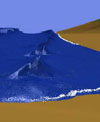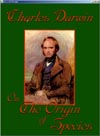
Simulating Curling and Breaking Waves
Brian W. Smith
Modeling natural phenomenon has long been a difficult problem in computer graphics as evidenced by the numerous approaches to different aspects of nature. Liquid simulation has been one of the more complex challenges until the introduction of methods based in Computational Fluid Dynamics. These approaches, although realistic due to their basis in physics, are too computationally expensive to model large volumes of liquid such as an oceanoscape. This paper presents an approximation method for realistic simulation of curling and breaking water waves on approach to a beach. The model consists of a collection of surface markers to keep track of the surface of the wave. As a wave train moves across the surface, the markers are pulled and then pushed from the wave center in a clockwise fashion, simulating the orbital motion found in nature and creating realistic movements for both breaking and non-breaking waves. As the height of a wave increases through interaction with the terrain below the ocean surface, the wave will curl and then break in realistic manner. When a breaking wave is detected, spray is generated through the use of a particle system. The system can run in interactive rates for scenes of moderate complexity.
Thesis Source Code

Visual Models of Morphogenesis: A Guided Tour
Przemyslaw Prusinkiewicz, Mark Hammel, and Radomir MechRapid progress in the modeling of biological structures and simulation of their development has occurred over the last few years. It has been coupled with the visualization of simulation results, which has led to a better understanding of morphogenesis and given rise to new procedural techniques for realistic image synthesis. This hypertext document reviews models of morphogenesis with a significant visual component, which were developed or reproduced in the Computer Science Departments at the University of Regina (1987 - August, 1991) and the University of Calgary (September, 1991 - present). The material is based on papers [Pru1993, Pru1994a], which cover the topic in more depth and include more extensive lists of references.

On the Origin of Species
Charles DarwinThis is the classical book in which Charles Darwin describes his theory of evolution. Although this book is not directly related to the graphical simulation of nature, I thought it might be of general interest. To read this book you need Microsoft Reader.